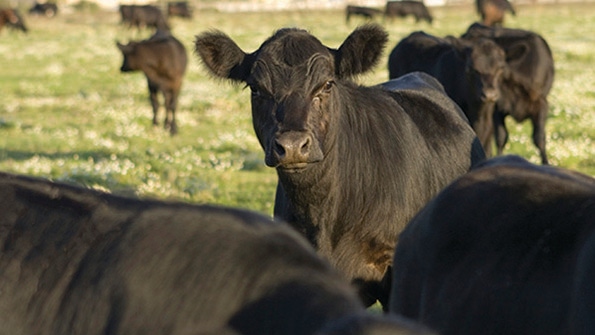Proven technology adds pounds, solves grazing challenges in pasture cattle
Manage grazing challenges in pasture cattle by using a proven technology to add pounds and manage coccidiosis.
June 21, 2016

Sponsored Content
Though techniques for managing pasture cattle have evolved over time, cow/calf and stocker operators are still at the mercy of Mother Nature. Too much rain, not enough rain and extremes in temperature can impact the quality and quantity of forage for grazing cattle. In addition, extremely wet conditions can increase exposure to coccidia, which are detrimental to cattle health, especially in young calves.
Rumensin® is a proven technology that solves multiple challenges as cow/calf and stocker operations try to maintain cattle health and improve performance, particularly when forage is lacking or limited.
“For years, Rumensin has been used to enhance feed efficiency in feedlot cattle, but it also is a cost-effective and proven technology that improves weight gain in grazing cattle,” says Lee-Anne Walter, Ph.D. and Elanco technical consultant.
“Ultimately beef producers are selling pounds. Whether that comes in the form of heavier stocker cattle or a heavier, more uniform calf crop, Rumensin is a tool that can be used to help improve average daily gain in stocker cattle, and feed efficiency in the cow herd. In fact, it is the only ionophore approved for use in all production phases in the beef industry — including mature, reproducing beef cows.”
Cows: Make the most of available forage and produce more pounds
Achieving high pregnancy rates while maintaining low feed costs is critical to the profitability of cow/calf operations. It is well documented that adequate energy in the diet is needed so cows can reach and maintain a targeted body condition score (BCS) of 5 through the postpartum interval and into the breeding season. An ideal BCS leads to a shorter return to estrus and higher first-service conception rates.1 Feeding Rumensin increases the energy available from feedstuffs, making it an economical source of improved energy utilization. Rumensin can help cows better use energy from available forage — either grazed or harvested for later use — and ultimately helps producers reach the end goal: a heavier, more uniform calf crop delivering more pounds weaned per cow exposed.
Applications for feeding Rumensin in the cow herd include:
Utilizing as a management tool to maintain BCS and assist along with adequate dietary supplementation in improving productivity of cows that have fallen below BCS 5
Enhancing animal performance when feeding low-quality harvested forages
Reducing feed costs when hay prices are high
Replacement heifers: Boost reproductive performance
“Feeding Rumensin to replacement heifers is a great way to launch their lifetime productivity in the cow herd,” says Walter. “We’ve known for a long time that replacement heifers reach puberty earlier when fed higher energy diets compared to those fed lower energy, low-quality forage diets.”
Studies have also demonstrated that heifers receiving Rumensin reached puberty and first estrus from 10 to 21 days sooner than those not fed Rumensin.2
Stocker cattle: Improve ADG to optimize value per head
Stocker cattle fed Rumensin can gain an additional 20 pounds or more per head during a 100-day grazing period, 3 at a cost of just pennies per head per day. Rumensin consistently improves average daily gain (ADG), since it helps cattle get the most from their diet, even as forage quality and sources change due to environmental conditions throughout the grazing season. A variety of feeding options are available to fit each operator’s management practices including use in complete feeds, supplements and FDA-approved blocks or free-choice minerals.
Preventing and controlling coccidiosis
Another benefit of Rumensin is its effectiveness in controlling and preventing coccidiosis. “Coccidia are endemic to the cattle population in the United States,” says Walter. “Calves, due to their reduced immunity, are likely to develop coccidiosis, even though five percent or less may show clinical signs.4 So, feeding Rumensin through the grazing season will prevent the subclinical aspects of coccidiosis from reducing gains.”
Young calves are the most susceptible to coccidiosis, especially if they are exposed to cow manure during wet weather when herds are grouped in small feeding areas in late winter or early spring. Cattle spread out on dry pasture keeps the coccidia oocyst passed in manure diluted over a larger surface area to reduce the opportunity of exposure.
“As producers wean calves, including Rumensin in the ration at the labeled rate will prevent clinical outbreaks of the disease during this stressful time in the calves’ lives and also help break the protozoan’s life cycle to reduce further incidence,” Walter concludes.
For more information about the benefits of Rumensin in grazing cattle, talk with your local Elanco sales representative or read more at Elanco.us.
Consumption by unapproved species or feeding undiluted may be toxic or fatal. Do not feed to veal calves. The label contains complete use information, including cautions and warnings. Always read, understand and follow the label and use directions.
1Thomas, E. 1978. “Critical Point” Feeding of Rumensin in the Beef-Cow Operation.” Elanco Animal Health. Rumensin Technical Manual for Pasture and Range Cattle.
2Elanco Animal Health. Data on file.
3Rathmacher, R. 1977. 24 trials. Elanco Animal Health. Data on file.
4Dedrickson, Coccidiosis in Beef Calves http://www.cabnr.unr.edu/resources/cattlemens/2001/06.htm
Rumensin® is a trademark for Elanco’s brand of monensin sodium.
You might also like:
When is the best time to wean? It might be younger than you think
You May Also Like



